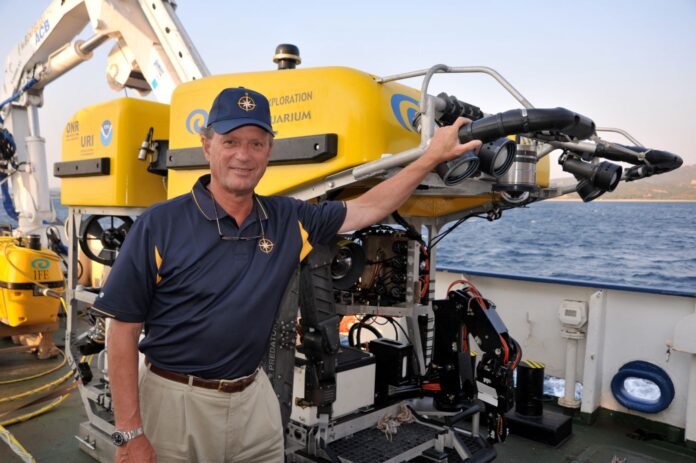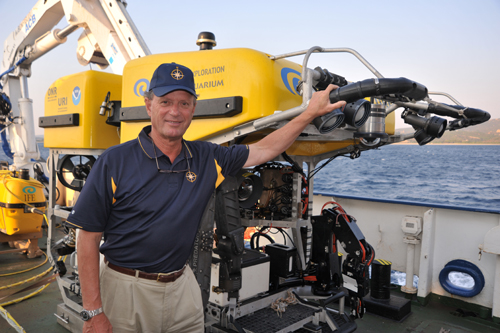One is a legendary explorer who now works in films. The other is a legendary filmmaker who now explores. Robert Ballard and James Cameron are woven into Titanic history, deep-sea exploration lore and each other’s lives.
Ballard is a marine biologist whose discoveries include such shipwrecks as the German battleship Bismarck, the USS Yorktown, John Kennedy’s PT-109 and most famously, Titanic. He has also discovered hot air vents 9,000 feet under the Pacific Ocean near the Galapagos Islands and helped develop the technology that allows deep-sea exploration without risk to human divers. He is also a documentary filmmaker, working on series and specials with National Geographic.
His friend Cameron is also known for developing technology, employing special effects advances on the world’s two highest-grossing films, “Avatar” ($2.8 billion worldwide) and “Titanic” ($1.9 billion worldwide and counting with its current 3-D release). Cameron’s underwater explorations include visits to the Titanic wreck site and a recent one-man dive nearly seven miles deep into the Mariana Trench.
During a March 26 telephone interview, Ballard discussed Cameron, Titanic and how technology impacts deep-sea exploration.
Toledo Free Press: It’s interesting to speak to you just hours after your friend James Cameron made his dive to the Mariana Trench. Were you involved in that expedition?
Robert Ballard: He is an amazing guy. I just flew in from London so I have not seen any footage, but I have been well aware of the expedition. We are good friends, and we have been communicating about it for quite a while. We all know one another. It’s a big ocean and there is plenty of room for a lot of us.
TFP: How long have you collaborated with Cameron?
Ballard: Jim and I have been friends for a long, long time. He contacted me shortly after I found Titanic. He came and visited me and I helped plot his strategy. During the filming of “Titanic” he would call me. Remember, when the movie starts, the ship has already been found.
He was mostly interested in footage I had taken, how I got into the ship, because he wanted to film in it as well. It’s always been a close association. He invited me to the premiere in 1997 and we’ve remained good friends.
TFP: You have very strong feelings about preserving Titanic. When Cameron first contacted you, did you have misgivings?
Ballard: He shared my views on not taking things from Titanic. We shared the same philosophy and we collaborated. He just lent me some of his powerful lights for my next expedition.
TFP: There is an explorer in Cameron’s film named Bobby who resembles you. Will you see the new 3-D version of “Titanic”?
Ballard: Of course, I’m excited to see the 3-D version. I shoot in 3-D, so I am familiar with the technology.
TFP: What 100th anniversary observances are you involved in?
Ballard: We have quite a number of projects. There’s a cover story in the current issue of National Geographic, television shows about Titanic, an exhibit at Mystic Aquarium here in Connecticut and a huge project in Belfast, Ireland, we’ve been working on for four years — Titanic Belfast’s Ocean Exploration Centre — which will help enthuse people about our oceans. There will be a lot of activity, then we’ll move on.
TFP: You had relationships with some of Titanic’s survivors. Your choice to explore the ship but not take anything from it must have encouraged a bond.
Ballard: I knew a number of survivors, Eva Hart [who died in 1996] in particular. All the survivors, all the families who lost relatives, all felt the ship should be left alone. The Smithsonian felt it should be left alone, the British Museum felt it should be left alone, all of the people closely associated with the Titanic felt it should not be desecrated.
TFP: Your list of discoveries is legendary, but Titanic is your best-known find. When you discovered the wreck site, you could not have known how big a role Titanic would play in your life.
Ballard: When I first started looking for Titanic, I wasn’t that emotionally attached to it but when I found it the ballgame changed. The most important discovery was finding where the humans landed. Titanic sank fairly quickly, but hundreds of people went over without life jackets, succumbed to hypothermia and fell to the ocean floor. Their bodies were eaten by the animals, their bones dissolved, but their shoes are left there as their tombstones.
So all over the debris field you have pairs of shoes, and those are very powerful images. Titanic spoke to me.
TFP: We know now that your search for Titanic was almost a cover operation for a U.S. Navy project.
Ballard: Titanic gave me an opportunity to take some missions that were classified at the time. They dealt with finding two nuclear submarines that we lost during the Cold War, the Thresher and the Scorpion. We did not want the Soviet Union to know where those submarines were, so Titanic provided a convenient distraction while we found the submarines.
TFP: Very few people will ever experience a deep-sea dive on the scale you have made. How do you excite people about such exploration?
Ballard: It’s clearly like going to another planet. Most of our planet is covered by deep water, not meant for humans to live in; we can only make short visits. But there are tremendous resources and knowledge to be gained. That is why we go.
We may never live in the deep sea but we will most certainly one day move onto the ocean’s surface; we’re doing that now as thousands of people live on oil platforms. I see a day when more people will live on the ocean.
TFP: How has technology affected the adventurous elements of exploration?
Ballard: More and more often we’re using robots; I don’t physically go like I used to. I am more interested now in exploring and learning than I am in the experience of diving. It’s sort of like, I like horseback riding, but I don’t ride the horses to work. I’m looking at the most efficient way of doing it. I can do most of the robotic operations from land; I don’t even have to go to the sites. What I learn is more important than how I learn it.
TFP: With the adventures and dangers you have faced, do you find a hard time putting in an average day? After you’ve been two miles under the ocean surface, how do you approach a normal day in everyday life?
Ballard: It’s no different. My community is very nice and quiet; I was just at the store buying my salad for lunch, and no one treats me differently. I put my pants on one leg at a time, just like everyone else.
Michael S. Miller is editor in chief of Toledo Free Press and Toledo Free Press Star.
























